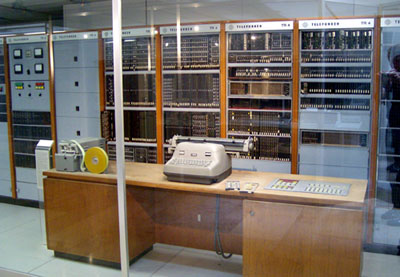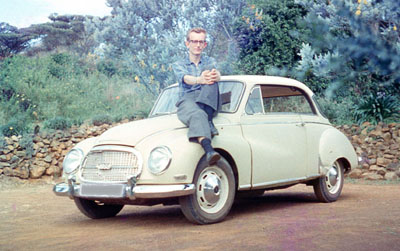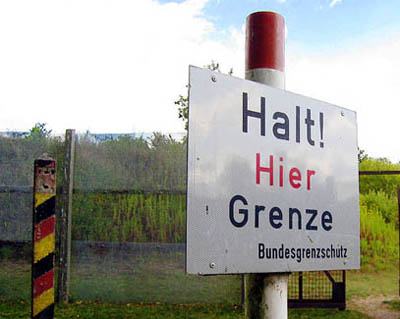- and some East German Border Guards.
|
In 1966 I was working in The Netherlands for a British computer company. Amongst other tasks, I “looked after” a large mainframe
leased by the Technical High School of Delft (actually a “Technical University” and known as such today). The machine I helped install there (an ICT 1905) had displaced a rather wonderful (but now very obsolete) early computer – a Telefunken TR4, of which only a few were ever built.
This replacement had caused a problem for one department in the University. They had a data collection (a “file” in today’s parlance) of about 50,000 punched cards. These contained information obtained over many years from medical surveys of human patients. The cards were stored in about 25 metal “card trays” held in two metal filing cabinets. These cards were then processed (read by the computer) multiple times with different program settings to select different factors to gain statistical insights such as regression and correlation analyses across various data values.. The problem was that the program that ran these statistics only ran on a Telefunken TR4.
It was a rare machine to start with, and there weren’t many of them around. And of those that still existed, their numbers were dwindling rapidly as they were being replaced with more modern equipment. It was decided that the punched card “Data Collection” should be transported to Berlin where there was still a TR4 in operation at an institute within the Free University there. Because of the logistics and politics of what was involved, it was decided that the most expedient way of getting the cards from one place to another was just to drive them there in the trunk of a private car driven by a volunteer. This would save on packing (which would have involved making one or two large crates) and arranging air transport and handling for these crates as well as all the paper work and coordination of the ground and air portions of the transport. I was the proud owner of a car, and was happy to volunteer for an expense-paid drive to Berlin and back.
I explain this all because it has a bearing on what happened next. We loaded the boxes of punched cards into the trunk of my trusty DKW, and I set out for Germany. Soon I was at the Dutch border, and the next part of my journey was through what was then still named “West” Germany. At some point I entered the “corridor” that would take me to Berlin through “East” Germany.
As a result, the corridor was a fairly fast drive – it was not a real “Autobahn” like could be found elsewhere in Germany, nevertheless there was minimal cross-traffic or entrances and exits, and there was a decent separation from the opposite lanes. But - like on the Autobahn - there was no speed limit on some of the longer uninterrupted segments. Thus a relatively high speed could be maintained for quite a while without slowing down or stopping at all. It was a sustained fairly fast drive until one reached the border of West Berlin at the end of the corridor. At this point one had to stop in a parking lot at the border, exit the car with one’s paper work and go into the “Douane” building to have passport, insurance, and “carnet de passage” checked by the East German border guards. Accordingly I slowed down on entering the clearly marked border zone, parked the car in an empty space and started walking to the Guard Building with my papers – all the while under the concentrated gaze of a number of soldiers dressed in unfamiliar uniforms, and armed with menacing submachine-guns. I locked my car door and started walking… when a loud explosion occurred just behind me and the guards all leapt to action stations. In a matter of a split-second I had followed orders to lie flat on the ground - and a number of submachine-guns were covering me. I was pretty sure this would be the end of it – just one trigger-happy East German Guard and I would be history… After I had been yanked to my feet, hand-cuffed and taken into the guard post, there was time to try and figure out what happened. My car was opened – the doors, the trunk, the hood, and every nook and cranny examined. And finally the evidence was found – the exhaust expansion-chamber and muffler under the car were distorted and split from the explosion. It seems that when I turned off the ignition, there was no more spark delivered by the spark plug in each cylinder – but the high revving engine continued to spin for a second or so – sucking in unburned fuel/air mixture from the carburetor, and pushing it out via the ceramic-lined exhaust manifold into the red-hot expansion chamber. Here the unburned gases collected for a second or so until (we later surmised) some portion of the mixture reached a spot of still-glowing soot (carbon) somewhere in the system. This small lump of carbon had become hot enough during the sustained fast drive through the corridor, that it had ignited and started glowing, and had then persisted briefly like a glowing coal inside the exhaust system after I switched off the ignition. Meanwhile, the engine had continued to spin down for a second or two – pushing unburned fuel mixture to where it eventually reached the source of ignition. A spectacular backfire explosion resulted. It took a while for all this to be figured out, for the handcuffs to be removed, and for my papers to be checked. The expansion chamber and muffler were ruined – when I was at last permitted to start the car again, the deafening noise of the exhaust made my little car sound like a monster aircraft taking off. I was allowed to proceed into Berlin where I managed to locate a garage who fixed the car over the course of a few days after replacement parts had been brought in from West Germany (through the corridor of course). The punched cards were duly delivered to the University’s computer center, and I made my way back to The Hague and Delft. But now, every time after a sustained high-speed run, I made sure to let the engine idle for a little while, and cool down for a moment, before I switched off the ignition. In today’s terms, the 50,000 punched cards, each holding up to 80 bytes of data, would amount to a file of roughly four Megabytes. I could transfer this file from my computer (where it might represent a just a single photo image) to another computer anywhere in the world reached by the internet, in under a second. Thankfully, there are no longer any East German Border Guards, and many times the mighty computing power of the Telefunken TR4 is now immediately to hand in the breast pocket of most every teen-ager living in the Western World. |
<


